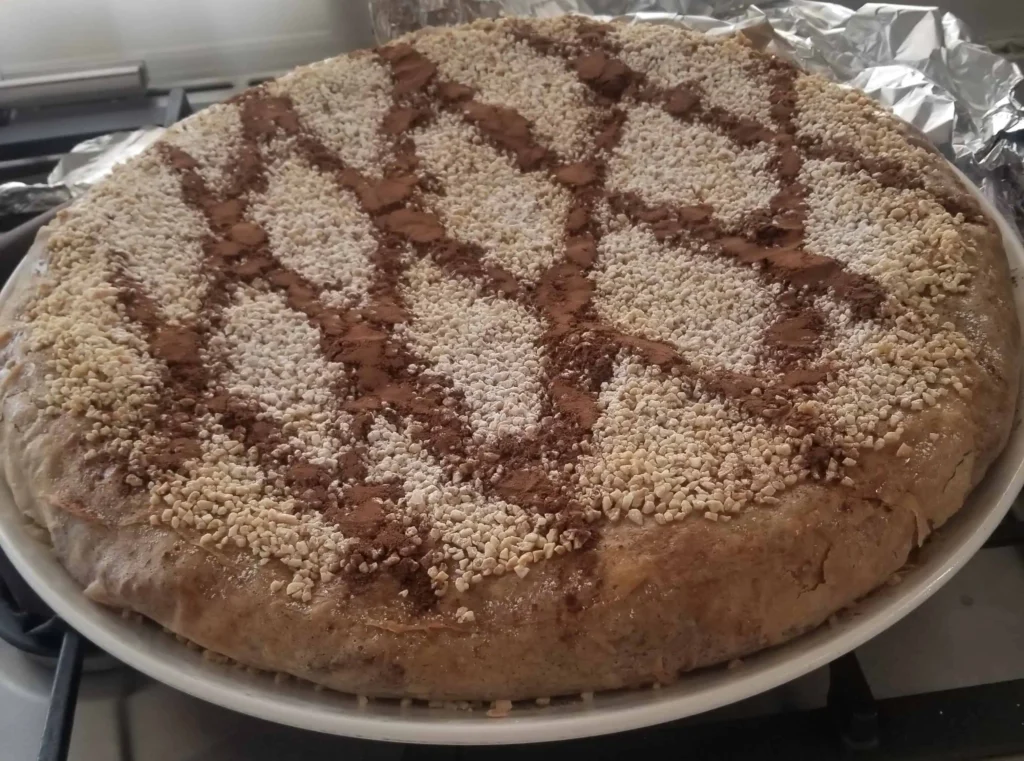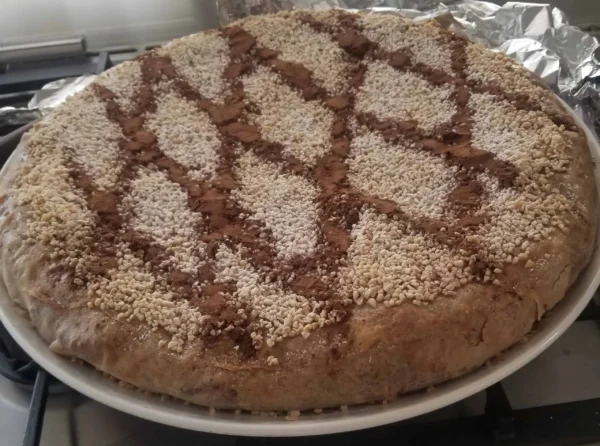Introduction
What is Moroccan Chicken Pastilla?
Moroccan Chicken Pastilla, also known as Bastilla or B’stilla, is a traditional Moroccan pie made with layers of crispy pastry, spiced shredded chicken, almonds, and a delicate dusting of cinnamon and powdered sugar. It is a celebratory dish often served at weddings, family gatherings, and special feasts.
The Unique Blend of Sweet and Savory Flavors
What makes Moroccan Chicken Pastilla unique is its perfect balance of sweet and savory elements:
- Savory chicken filling cooked with onions, saffron, cinnamon, and spices.
- Sweet contrast from a layer of ground almonds, cinnamon, and sugar.
- Crispy golden pastry made with warqa dough or phyllo dough.
This combination creates a rich, flavorful dish that is crispy on the outside, tender and aromatic on the inside.
Why Pastilla is a Special Dish in Moroccan Cuisine
- Symbol of hospitality – Often served to honor guests.
- Perfect for celebrations – Found at weddings, Ramadan feasts, and festive gatherings.
- A showcase of Moroccan culinary artistry – Combines Andalusian, Arab, and Berber influences.
Table of Contents
The History and Cultural Significance of Moroccan Chicken Pastillailla
Moroccan Chicken Pastilla is more than just a dish—it is a symbol of Moroccan culinary excellence, blending flavors and techniques influenced by Andalusian, Arab, and Berber traditions. This rich history makes pastilla an iconic meal in Moroccan cuisine.
1. The Origins of Pastilla
The roots of pastilla can be traced back to Al-Andalus (Muslim Spain) during the Moorish era (8th–15th centuries). When the Moors were expelled from Spain, they brought their cooking traditions to North Africa, particularly Morocco. This led to the development of dishes that combined rich spices, nuts, and delicate pastries, which are hallmarks of Moroccan cuisine today.
The word “pastilla” comes from the Spanish word “pastel”, meaning pie or pastry. Originally, pastilla was made with pigeon meat, a delicacy at the time. Over the centuries, chicken became the more common filling, making the Moroccan Chicken Pastilla more accessible.
2. How Pastilla Became a Staple in Moroccan Celebrations
Pastilla is a dish reserved for special occasions, as it requires careful preparation and skill. It is often served at:
✔ Weddings and Engagements – A centerpiece dish symbolizing hospitality and abundance.
✔ Family Feasts and Holidays – Common during Ramadan, Eid, and large family gatherings.
✔ Honoring Guests – In Moroccan culture, serving pastilla is a sign of respect and generosity.
Its combination of savory chicken, aromatic spices, and sweet almonds makes it one of Morocco’s most luxurious dishes.
Why Pastilla Remains a Symbol of Moroccan Cuisine
✔ Represents Morocco’s cultural heritage, blending Andalusian, Arab, and Berber influences.
✔ A perfect balance of flavors—sweet, savory, crispy, and aromatic.
✔ A dish of celebration, bringing families and communities together.
Essential Ingredients for the Perfect Moroccan Chicken Pastilla
The secret to an authentic Moroccan Chicken Pastilla lies in the quality of ingredients and the perfect balance of sweet and savory flavors. Here’s everything you need to make a traditional and delicious Moroccan Chicken Pastilla.
1. The Best Type of Chicken to Use
While pastilla was originally made with pigeon meat, chicken has become the more common and accessible option.
✔ Bone-in Chicken (Thighs or Whole Chicken) – Provides a richer, more flavorful broth.
✔ Boneless Chicken Thighs – Tender and juicy, ideal for shredding.
✔ Chicken Breast – Leaner but may require extra seasoning to avoid dryness.
🔹 Tip: If using bone-in chicken, cook it first and then remove the bones before assembling the pastilla.
try to see: health benefits of chicken.
2. Traditional Moroccan Spices and Flavorings
Moroccan pastilla gets its signature depth of flavor from a blend of warm spices and aromatics.
✔ Saffron: Adds a rich golden color and earthy aroma.
✔ Cinnamon: Used in both the filling and dusted on top for sweetness.
✔ Ginger & Turmeric: Essential for the savory, spiced chicken filling.
✔ Ras el Hanout: A Moroccan spice blend that enhances the dish’s complexity.
✔ Black Pepper & Salt: Balances the flavors and enhances the seasoning.
🔹 Tip: Always toast spices lightly in olive oil or butter before adding them to the chicken for a richer taste.

3. The Importance of Warqa (or Phyllo Dough)
The crispy, flaky layers of pastilla are made with warqa, a Moroccan handmade pastry dough. However, since warqa is difficult to find outside Morocco, phyllo dough is a great substitute.
✔ Warqa Dough: Traditionally used, ultra-thin, and crispy.
✔ Phyllo Dough: A widely available alternative; use multiple layers to mimic warqa.
✔ Brik Pastry: Used in Tunisia and Algeria, slightly thicker than warqa but works well.
🔹 Tip: Brush each layer with melted butter or oil to ensure a crispy, golden crust.
4. Almond and Sugar Filling (The Sweet Element)
A key feature of Moroccan pastilla is the layer of crushed almonds mixed with sugar and cinnamon. This sweet element contrasts beautifully with the spiced chicken filling.
✔ Blanched Almonds: Lightly fried or toasted, then ground.
✔ Powdered Sugar: Adds a touch of sweetness.
✔ Cinnamon: Enhances the warm, fragrant notes of the almonds.
🔹 Tip: For extra crunch, leave some almond pieces slightly coarse rather than grinding them completely.
5. Eggs for a Rich, Silky Texture
Pastilla also includes a layer of eggs cooked in the chicken sauce, creating a silky, custard-like texture inside the pie.
✔ Eggs are whisked and cooked in the leftover spiced chicken broth until they thicken.
✔ This adds moisture and richness, ensuring that the pastilla isn’t dry.
🔹 Tip: Stir the eggs constantly while cooking to create a smooth, creamy texture.
How to Make Moroccan Chicken Pastilla at Home
Making authentic Moroccan Chicken Pastilla requires patience and layering techniques to achieve the perfect balance of crispy pastry, spiced chicken, and sweet almonds. Follow this step-by-step guide to create a delicious pastilla at home.
1. Preparing the Chicken Filling
Step 1: Cook the Chicken with Spices
- Heat 2 tablespoons of olive oil in a large pot over medium heat.
- Add 1 finely chopped onion and cook until soft.
- Stir in 2 teaspoons ground ginger, 1 teaspoon turmeric, ½ teaspoon black pepper, and a pinch of saffron.
- Add 2 pounds of bone-in chicken thighs or a whole chicken, cut into pieces.
- Pour in 1 cup of water or chicken broth and 1 cinnamon stick, then cover and simmer for 30–40 minutes until tender.

🔹 Tip: Stir occasionally and check the liquid level to prevent burning.
Step 2: Shred the Chicken
- Remove the chicken from the pot and let it cool slightly.
- Discard the bones and shred the meat into small pieces.
- Set aside and reserve the flavorful broth for the next step.
2. Preparing the Egg Mixture
- Bring the reserved broth to a simmer.
- Crack 4 eggs into the broth and whisk continuously until the eggs thicken into a soft, creamy texture.
- Remove from heat and let the mixture cool.
🔹 Tip: Stir constantly to prevent overcooking the eggs into a solid mass.
3. Preparing the Sweet Almond Filling
- Toast 1 cup of blanched almonds in a pan until golden brown.
- Let them cool, then pulse in a food processor with:
- 2 tablespoons powdered sugar
- 1 teaspoon cinnamon
- Blend until finely ground but still slightly crunchy.
🔹 Tip: A touch of orange blossom water can enhance the flavor.
4. Assembling the Moroccan Chicken Pastilla
Step 1: Layer the Pastry
- Preheat the oven to 375°F (190°C).
- Brush a 9-inch round baking dish or ovenproof pan with melted butter.
- Layer 5–6 sheets of phyllo dough or warqa, brushing each sheet with butter. Let the edges hang over the sides of the pan.
Step 2: Add the Filling
- Spread the chicken mixture evenly over the bottom layer of pastry.
- Add the creamy egg mixture on top.
- Sprinkle the sweet almond mixture evenly over the eggs.

Step 3: Seal the Pastilla
- Fold the overhanging phyllo sheets over the filling to seal it.
- Add 2 more layers of phyllo dough on top for extra crispiness, brushing each with butter.
- Tuck in the edges and brush the top with an egg yolk mixed with a little milk for a golden finish.
5. Baking the Pastilla
- Bake at 375°F (190°C) for 30–35 minutes or until golden brown and crispy.
- Remove from the oven and let it cool for 5 minutes.
- Flip onto a serving plate and dust with powdered sugar and cinnamon.
🔹 Tip: For extra crispiness, broil the pastilla for the last 2–3 minutes.
Variations of Moroccan Pastilla
Moroccan pastilla is a versatile dish that can be adapted with different fillings while keeping its signature crispy pastry and balance of sweet and savory flavors. Here are some of the most popular variations.
1. Classic Moroccan Chicken Pastilla with Almonds (Traditional Recipe)
✔ The most well-known version, made with shredded chicken, saffron, eggs, almonds, and cinnamon.
✔ Wrapped in warqa or phyllo dough and baked until crispy.
✔ Topped with powdered sugar and cinnamon for a sweet contrast.
🔹 Best for: Weddings, celebrations, and formal gatherings.
2. Seafood Pastilla (Coastal Moroccan Specialty)
✔ Found in coastal cities like Casablanca and Essaouira.
✔ Filled with shrimp, calamari, white fish, and vermicelli noodles.
✔ Uses a creamy saffron-infused sauce instead of the egg mixture.
🔹 Best for: Seafood lovers and lighter meals.
🔹 Tip: Serve with a wedge of lemon for a fresh citrus touch.
3. Pigeon Pastilla (The Royal Version)
✔ The original pastilla, made with pigeon instead of chicken.
✔ Considered a delicacy in Moroccan royal cuisine.
✔ Has a richer, gamier taste than chicken pastilla.
🔹 Best for: Traditional Moroccan dining experiences.
🔹 Tip: If pigeon is unavailable, substitute with duck or Cornish hen for a similar texture.
4. Vegetarian Pastilla (A Modern Twist)
✔ Uses mushrooms, caramelized onions, and nuts instead of meat.
✔ Seasoned with cinnamon, saffron, and ras el hanout.
✔ Can include lentils, chickpeas, or tofu for added protein.
🔹 Best for: Vegetarians or those looking for a lighter option.
🔹 Tip: Toasted pine nuts add extra flavor and texture.
5. Mini Pastillas (Appetizer or Party-Style Bites)
✔ Uses the same ingredients as the classic recipe but shaped into small, individual portions.
✔ Perfect for cocktail parties, appetizers, or tapas-style servings.
✔ Can be baked or deep-fried for extra crispiness.
🔹 Best for: Parties, special occasions, and plated appetizers.
🔹 Tip: Serve with a side of harissa or honey glaze for dipping.
6. Gluten-Free Pastilla (Diet-Friendly Adaptation)
✔ Uses rice paper or gluten-free tortillas instead of phyllo dough.
✔ Follows the same layering and filling techniques as the traditional version.
✔ Keeps the rich Moroccan flavors while being gluten-free.
🔹 Best for: Gluten-sensitive individuals or those on special diets.
🔹 Tip: Brush rice paper lightly with olive oil to achieve a crispier texture.
Best Side Dishes and Drinks to Serve with Moroccan Chicken Pastilla
Moroccan Chicken Pastilla pairs well with a variety of side dishes and beverages that enhance its rich, sweet, and savory flavors.
Traditional Moroccan Side Dishes:
- Zaalouk (smoky eggplant dip) – A flavorful contrast to the crispy pastilla.
- Taktouka (tomato and roasted pepper salad) – Adds freshness and acidity.
- Harira soup – A comforting soup often served at Moroccan feasts.
Beverage Pairings with Moroccan Chicken Pastilla:
- Moroccan Mint Tea – The classic drink to complement the dish’s sweetness.
- Fresh Orange Juice – A light, citrusy contrast to the rich flavors.

🔹 Tip: Serve pastilla as a centerpiece dish, with a variety of Moroccan salads for a complete meal.
Tips for Making the Best Moroccan Chicken Pastilla
To ensure a perfectly crispy and flavorful Moroccan Chicken Pastilla, follow these expert tips:
✔ Use multiple layers of phyllo dough or warqa, brushing each with butter for crispiness.
✔ Balance the sweet and savory elements by adjusting cinnamon and sugar levels to taste.
✔ Let the filling cool completely before assembling to prevent a soggy pastry.
✔ Bake at the right temperature (375°F/190°C) for an evenly golden crust.
✔ Sprinkle powdered sugar and cinnamon lightly—don’t overpower the dish.
🔹 Tip: Make pastilla ahead of time and refrigerate it unbaked, then bake just before serving for the freshest texture.
Common Mistakes to Avoid When Making Moroccan Chicken Pastilla
Avoid these mistakes to get the best results:
- Overstuffing the pastilla – Too much filling can break the pastry.
- Not sealing the edges properly – The filling may leak during baking.
- Using wet or hot filling – This leads to soggy pastry.
- Skipping the butter between layers – The pastry won’t turn golden and crispy.
- Not tasting the filling before assembling – Adjust seasoning to ensure the perfect balance of flavors.
🔹 Tip: Always bake Moroccan Chicken Pastilla on a parchment-lined tray to avoid sticking.
Frequently Asked Questions (FAQs) about Moroccan Chicken Pastilla:
1. What does Moroccan Chicken Pastilla taste like?
Moroccan Chicken Pastilla offers a perfect balance of flavors—savory, slightly sweet, and aromatic. The spiced chicken is infused with saffron, ginger, and cinnamon, while the crunchy almonds add a nutty contrast. The flaky pastry and dusting of sugar create a delicate, crispy texture.
2. Can I make Moroccan Chicken Pastilla without warqa pastry?
Yes! If you can’t find warqa pastry, you can use phyllo dough as a substitute. Phyllo dough is widely available and works well to create the crispy, layered texture of traditional Pastilla.
3. How do you serve Moroccan Chicken Pastilla?
Pastilla is usually served as an appetizer or main course during special occasions, weddings, and celebrations. It is often cut into slices and enjoyed warm, paired with Moroccan mint tea.
4. Can Moroccan Chicken Pastilla be made ahead of time?
Yes! You can prepare the filling ahead of time and even assemble the Pastilla before baking. Store it in the refrigerator for up to 24 hours, then bake it fresh before serving.
5. How do you store and reheat Moroccan Chicken Pastilla?
To store, wrap leftovers tightly in plastic wrap or an airtight container and refrigerate for up to 3 days. To reheat, place it in a 350°F (175°C) oven for 10–15 minutes until crispy and warm.
6. Is Moroccan Chicken Pastilla gluten-free?
No, traditional Pastilla is made with warqa or phyllo dough, which contains gluten. However, you can try making a gluten-free version using rice paper or gluten-free phyllo dough alternatives.
7. What are some variations of Moroccan Pastilla?
While Chicken Pastilla is popular, there are other delicious versions, such as:
- Seafood Pastilla – Made with shrimp, calamari, and fish.
- Vegetarian Pastilla – Filled with spiced vegetables, nuts, and sometimes cheese.
- Milk Pastilla (Jowhara) – A sweet dessert version made with milk, almonds, and phyllo layers.
8. What side dishes go well with Moroccan Chicken Pastilla?
Since Pastilla is rich and flavorful, it pairs well with lighter sides such as:
- Moroccan mint tea
- A fresh Moroccan salad with tomatoes and cucumbers
- A citrusy orange and olive salad
- Harira soup (if served as part of a larger meal)
Moroccan Chicken Pastilla
Equipment
- Large skillet
- Baking Dish
- Pastry Brush
Ingredients
For the Chicken Filling
- 1 1/2 lb chicken thighs boneless, skinless
- 2 tbsp olive oil
- 1 onion finely chopped
- 2 cloves garlic minced
- 1 tsp ground cinnamon
- 1 tsp ground ginger
- 1/2 tsp ground turmeric
- 1 tsp salt or to taste
- 1/2 tsp black pepper
- 1/2 cup chicken broth
- 3 eggs beaten
For the Almond Mixture
- 1/2 cup almonds blanched and toasted
- 2 tbsp powdered sugar
- 1/2 tsp ground cinnamon
For the Pastry
- 8 phyllo dough sheets
- 4 tbsp butter melted
For Garnish
- 1 tbsp powdered sugar for dusting
- 1 tsp ground cinnamon for dusting
Instructions
- Heat olive oil in a large skillet over medium heat. Add the onions and garlic, sautéing until softened.
- Add the chicken, cinnamon, ginger, turmeric, salt, and black pepper. Cook until the chicken is browned.
- Pour in the chicken broth, cover, and simmer for 20 minutes until the chicken is tender.
- Remove the chicken, shred it, and return to the pan. Stir in the beaten eggs and cook until the mixture thickens. Set aside to cool.
- In a separate bowl, mix the toasted almonds with powdered sugar and cinnamon.
- Preheat oven to 375°F (190°C). Brush a baking dish with melted butter.
- Layer 4 phyllo sheets in the dish, brushing each with butter. Add the chicken mixture, then the almond mixture.
- Fold the phyllo sheets over the filling, then layer 4 more sheets on top, brushing each with butter. Tuck in the edges.
- Bake for 25-30 minutes until golden brown and crispy.
- Dust with powdered sugar and cinnamon before serving.
Notes
conclusion
Moroccan Chicken Pastilla is a celebration dish, offering a unique mix of crunchy, sweet, and savory flavors. By following the right techniques and avoiding common mistakes, you can make an authentic, restaurant-quality Moroccan Chicken Pastilla at home.
For more Recipes to Try
Check out these recipes:
- Amlou: The best Moroccan Almond and Argan Oil Spread Recipe
- 7 Moroccan Couscous Recipes: Authentic Recipes, Variations, and Health Benefits


